7 Step Effective Guide on How to Handle Angry Customers
This guide provides insights on managing angry customers effectively, understanding their grievances, offering solutions, ultimately enhancing customer satisfaction and loyalty for businesses.
Are you even running a successful business if you haven’t dealt with an angry customer at least once in the business’s lifetime?
When a customer is unhappy, they are more likely to leave a negative review almost immediately amongst their peers – which potentially damages the business reputation. Offer one less than average service and 96% of the customers will cut ties with a brand!
How to deal with angry customers, then? Although we might not at all eradicate irate customers, we can minimize their number. In this article, we’ll explore the strategies to manage as well as mitigate the negative interactions.
Angry customers are individuals who are dissatisfied with a product or service. They express their frustration, disappointment, or anger towards the company responsible for their negative experience. The dissatisfied customers may have encountered issues such as poor product quality, delayed delivery, rude customer service, or any other problem that has led to their dissatisfaction.
It is important for businesses to address the concerns of an irate customer effectively to prevent further damage to their reputation and to retain customer loyalty. Angry customers can have a significant impact on a company’s bottom line, as they may choose to take their business elsewhere and share their negative experiences with others through word-of-mouth or online reviews.
Key objectives:
We know customers are angry when they get back to us in a rather irate mood. But, what makes them angry? Is it poor product quality? Maybe. Here are few more reasons we can think of.
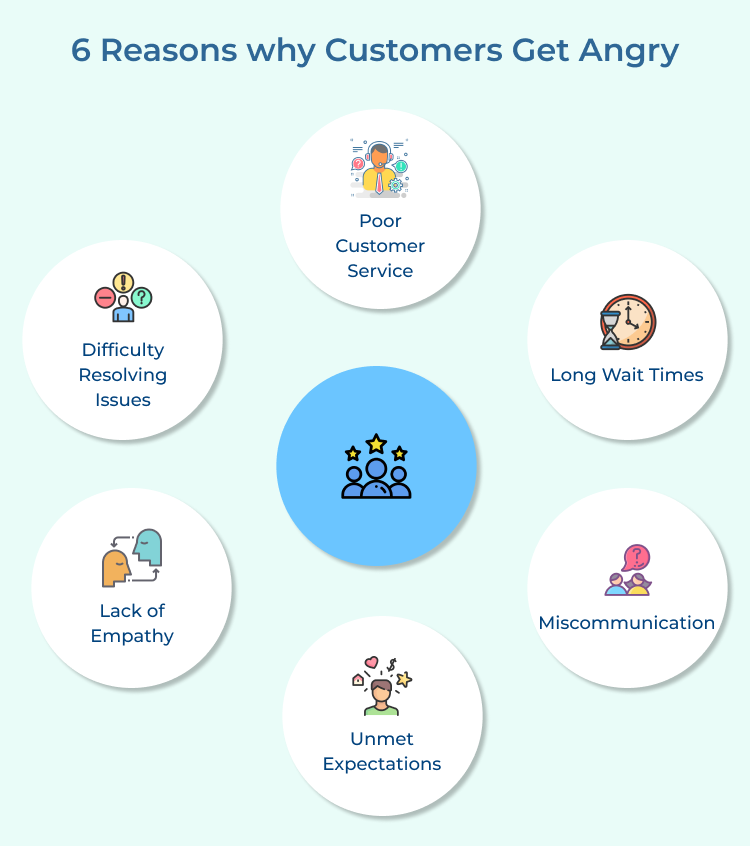
Whether you work in retail, hospitality, or any other industry that involves interacting with customers, you will encounter an upset customer at some point. Here’s how to deal with them:
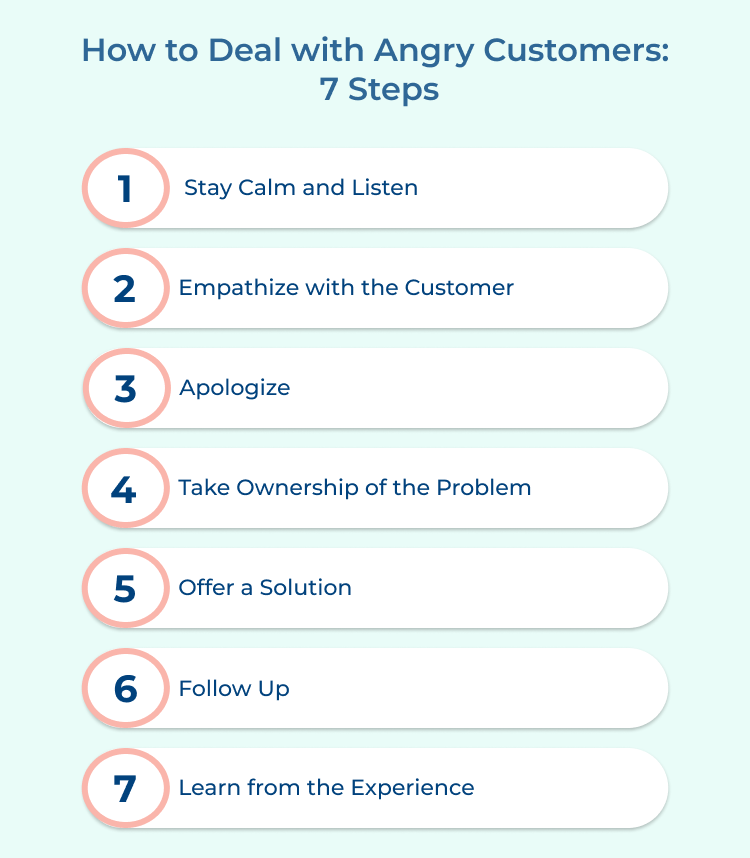
When dealing with an angry customer, it’s important to remain calm and composed. Take a deep breath and listen carefully to what the customer is saying. Let them vent their frustrations and express their concerns without any interruption. It’s important to show the customer that you are taking their concerns seriously and that you are willing to listen to them. Do not take what they say personally.
Put yourself in the customer’s shoes and try to understand why they are upset. Empathize with their situation and let them know that you understand their frustrations. Use phrases like “I can see why you would be upset” or “I would’ve felt the same in your place” to show empathy towards the customer.
Although the customer’s anger is not justified, it’s important to apologize for any inconvenience or misunderstanding. A sincere apology can go a long way in defusing the situation and showing the customer that you are committed to resolving their issue. Be sure to apologize even if you are not at fault, as it helps to calm the customer down and move towards a resolution.
Instead of placing blame or making excuses, take ownership of the problem and assure the customer that you will do everything in your power to resolve the issue. Show the customer that you are committed to finding a solution and that you are willing to go above & beyond to make things right.
Once you have listened to the customer’s concerns and empathized with their situation, it’s time to offer a solution. Work with the customer to find a resolution that meets their needs and addresses their concerns. It could involve issuing a refund, providing a replacement product or offering a discount on their next purchase. Be flexible and willing to compromise in order to satisfy the customer.
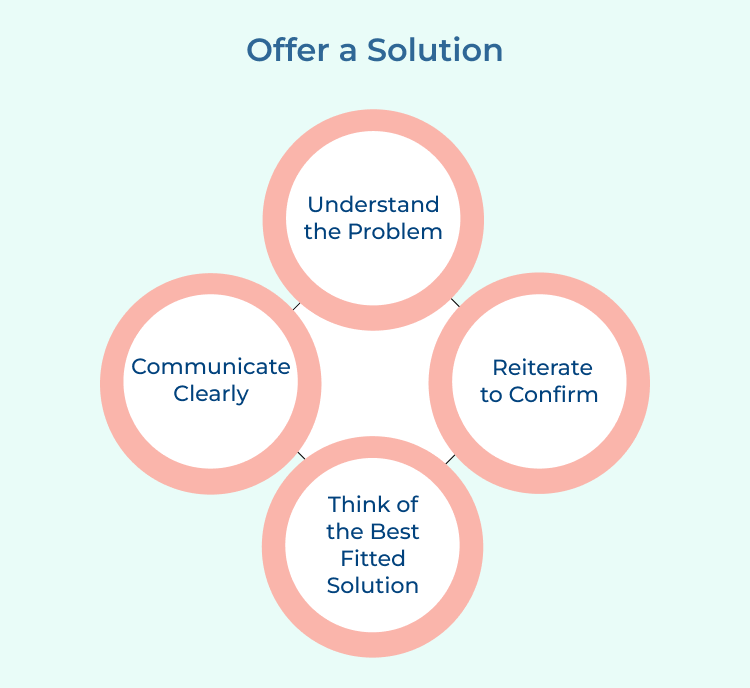
After the situation has been resolved, be sure to have a customer follow up to ensure that they are satisfied with the outcome. It could involve sending a follow-up email or making a phone call to check in on the customer. By following up, you show the customer that you value their business and that you are committed to providing excellent customer service.
Dealing with angry customers can be a learning experience. Take the time to reflect on the situation and consider what you could have done differently to prevent or resolve the issue more effectively. Use the feedback to improve your customer service skills and prevent similar situations from arising in the future.
What makes it important to help upset customers is that almost 80% of them will be forgiving to a brand if they receive good customer service! Here’s why negative experiences are important:

54% of the customers say customer service is an after thought for businesses. Now that we’ve discussed who they are and what they do, let’s focus on how to handle them.
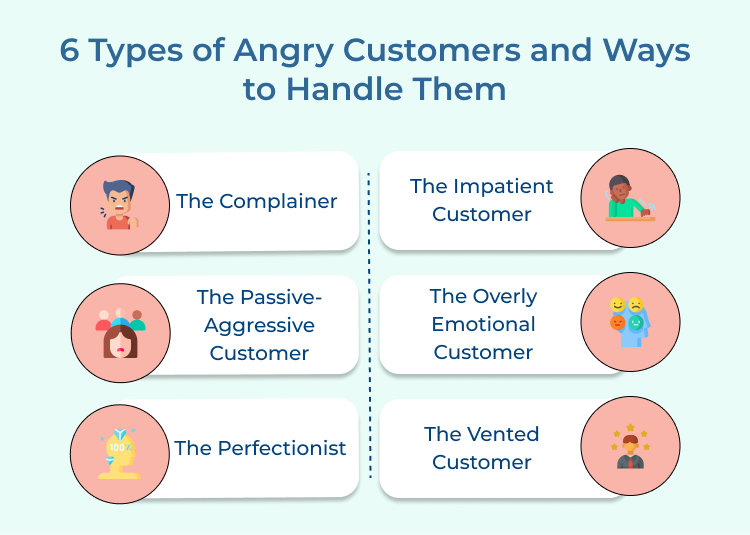
This type of customer is never satisfied and will find fault in everything. They will nitpick every detail and will often escalate minor issues into major complaints. The key to handling this type of customer is to listen attentively, show empathy, while offering alternatives to address their concerns.
Impatient customers want quick solutions and immediate attention. They’re often frustrated by long wait times or delays in service. An impatient customer needs quick resolutions. You give them what they need – respond promptly, acknowledge their frustrations and provide regular updates on the progress of their issue.
These customers may not show their anger outright, but they will express their frustrations in a subtle and indirect manner. They may make sarcastic comments or give backhanded compliments. Dealing with passive-aggressive customers requires patience and assertiveness. It is important to address their concerns directly and professionally.
This type of customer is easily triggered and may become emotional or irrational when expressing their concerns. They may raise their voice, cry or become overly dramatic. Handling overly emotional customers will require you to remain calm and offer reassurance. It is also important to set boundaries and maintain a professional demeanor.
Perfectionist customers have high expectations and will not settle for anything less than perfect. They may be demanding and critical, expecting flawless service at all times. To deal with perfectionist customers, it is important to exceed their expectations, address their concerns promptly and strive for excellence in all interactions.
A vented customer just needs to let off steam and vent their frustrations. They may not necessarily be looking for a resolution to their issue, but rather a sympathetic ear to listen to their complaints. Manage them by listening attentively, validating their feelings and offering support without taking their complaints personally.
Everybody makes mistakes everywhere, sometimes even while handling an irate customer too! And that’s okay! But, there are certain scenarios that one must definitely remember to avoid.
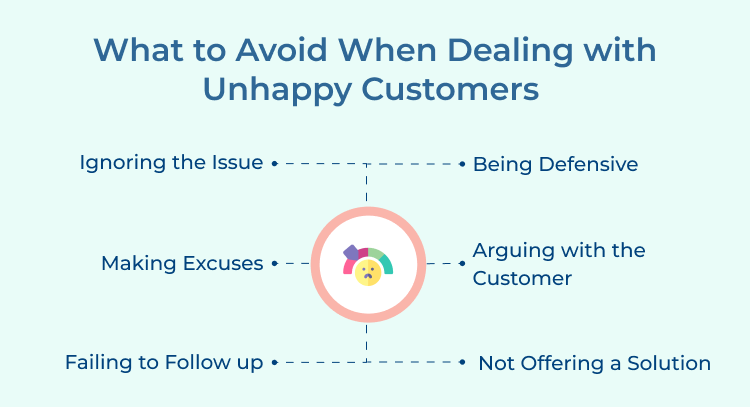
1. Ignoring the issue: One of the worst things you can do when a customer is unhappy is to ignore their concerns or dismiss them. Ignoring the issue will only make the customer feel unimportant and unheard, ultimately leading to further frustration.
2. Being defensive: It can be tempting to become defensive when a customer is complaining about your product or service. But, getting defensive will only make the situation worse and cause the customer to become even more upset. Instead, listen to their concerns and try to understand their perspective.
3. Making excuses: Making excuses for why the customer is unhappy is not a productive way to handle the situation. Instead of making excuses, take responsibility for the issue and work towards finding a resolution.
4. Arguing with the customer: Arguing with a customer will not solve the problem and will only escalate the situation. It’s important to remain calm and professional when dealing with unhappy customers, even if they are being difficult.
5. Failing to follow up: Once you have resolved the issue with the unhappy customer, schedule a follow up to ensure that they are happy. Failing to follow up can leave the customer feeling unimportant and leads to them taking their business elsewhere.
6. Not offering a solution: When a customer is unhappy, offer them a solution to their problem. Whether it’s a refund, a replacement product or an apology, offering a solution shows the customer that you value their business and are willing to make things right.
Whether you work in retail or any other industry where you interact with customers, you need to know how to handle their frustrations and concerns in an effective manner.

Dealing with angry customers is a common challenge that all businesses face. Here are some real-life examples of companies that have successfully turned angry customers into happy ones:
In 2007, a snowstorm caused the cancellation of hundreds of flights for JetBlue Airways, leaving passengers stranded and frustrated. Instead of ignoring the issue, JetBlue’s CEO, David Neeleman, took responsibility for the situation and issued a public apology. The company also implemented a Customer Bill of Rights, which outlined the compensation passengers would receive for future flight disruptions. This proactive response helped to restore customer trust and loyalty.
LEGO is known for its quality toys as well as customer service and they once sent a young boy a replacement toy after he lost his special edition LEGO set. The boy along with his family were delighted to have such beautiful gestures from LEGO’s and continued to be loyal customers.
The Ritz-Carlton is a luxury hotel chain that is known for its exceptional customer service. If a guest has a complaint or issue during their stay, the Ritz-Carlton staff will go above and beyond to make it right, whether it’s upgrading their room, offering a complimentary meal or providing a discount on their stay.
Warbly Parker is an eyewear company that offers a home try-on program, allowing customers to test out different frames before making a purchase. If a customer is not satisfied with their glasses, Warbly Parker offers free returns and exchanges to ensure that they find the perfect pair.
Adobe, a multinational software company, values customer feedback and strives to address issues promptly. When a software glitch affected a customer’s work, Adobe’s technical support team worked around the clock to resolve the issue and provided a complimentary upgrade as a gesture of goodwill. The customer was impressed by the company’s dedication to customer satisfaction.
The way a business handles angry customers can have a significant impact on its success. By addressing customer complaints and issues promptly, businesses improve customer satisfaction, loyalty as well as retention.
Failing to properly handle angry customers results in negative reviews, damage to the brand reputation, and loss of business. It is essential for businesses to train their employees on how to manage difficult customers as well as provide them with the tools and resources needed to resolve conflicts.
Treating angry customers with respect and care turns a negative experience into a positive one while also strengthening the relationship between the customer as well as the business.
What is the importance of dealing with angry customers?
Handling angry customers effectively transforms negative experiences into opportunities for building stronger relationships and demonstrating your company’s commitment to service excellence. When you address complaints properly, you often convert frustrated customers into loyal advocates who appreciate your responsiveness. This approach also prevents negative word-of-mouth marketing that could damage your reputation and drive away potential customers.
What makes a customer angry?
Customers typically become angry when they feel unheard, disrespected, or let down by unmet expectations regarding product quality or promised timelines. Poor communication, such as being transferred multiple times without resolution or receiving conflicting information, frequently escalates frustration. Additionally, customers feel anger when they perceive unfair treatment, hidden fees or when staff appear indifferent to their concerns and needs.
How to respond to an angry customer?
When responding to an angry customer, it is important to remain calm and composed. Acknowledge their concerns and apologize for any inconvenience they may have experienced. Listen actively to their complaints and try to find a solution that satisfies both parties. It is also important to communicate effectively and ensure the customer feels heard.
Is it worth it to deal with angry customers?
Dealing with angry customers can be challenging, but it is worth it in the long run. By handling these situations effectively, you have the opportunity to turn a negative experience into a positive one. Customers who have their concerns addressed efficiently are more likely to continue doing business with your company and may even become loyal customers in the future.